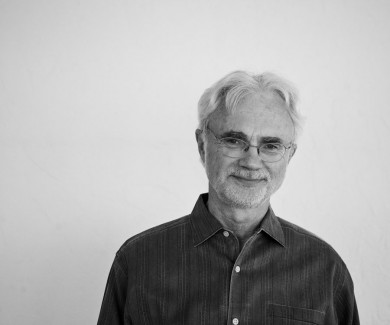John Adams leads New World in a dynamic, full-tilt “American” program

Composer John Adams conducted the New World Symphony Saturday night in Miami Beach. Photo: Deborah O’Grady
Bright colors and optimism at the New World Symphony’s Sounds of the Times concert Saturday night echoed the happy art trending at Art Basel, sharply contrasting with the Shut It Down protests in Miami the night before. The audience enjoyed the congenial “American Sound” program, conducted by John Adams, one of today’s most recognizable American composers.
Lithe and energetic, Adams prefers volume to finesse, and although capable of both, the New World Symphony committed to the weighty dynamic demands of the program.
Jagged meters, lyrical melodies, and rough edges defined Aaron Copland’s El Salon México from 1936, the opening work foreshadowing much of the night’s program stylistically and interpretively. Dancing repeated-note figures were offset by spicy dissonances, while unified brass, winds and an animated percussion section rendered Copland’s crisp orchestration. A melancholy trumpet solo from Ryan Darke and Ran Kampel’s glissy clarinet solos captured the essence of Copland’s 1930s music.
In introductory remarks about his own Saxophone Concerto from 2013, Adams described soloist Timothy McAllister as someone who “doesn’t have any fear.” The two-movement work was characterized by Adams’ signature propulsion and consonance, laced with echoes from his post-minimal period.
The Animato section of the triptych first movement offers perpetually rising scales for soloist and orchestra, which transitions into rising and falling arpeggios, mostly for the duration. Agile and sometimes contorted, McAllister relentlessly delivered the goods, riding the top of Adams’ melded composite of sound, although his contributions were fitfully minimized by the overbearing accompaniment.
The Moderato section’s dreamy, falling contours dispersed some tension, with riffs recalling Adams’ radio-friendly The Chairman Dances. The best moments of the concerto were found in McAllister’s melodies shifting seamlessly as they morphed through the ensemble. The suave Tranquillo section slowed considerably, although repeating string swells masked potentially reflective moments, as McAllister’s cascading melodies rose above mostly static harmonies.
Why the brief Molto vivo, a hard-driving section, is separate from the first movement is unclear. Here, despite McAllister’s exciting playing and more nuanced orchestration, the overall effect was one of saturation.
Adams introduced Andrew Norman’s Try from 2011 as “a little masterpiece.” Virtuosically conceived and passionately executed, it offers fourteen minutes of whirling, snapping, screeching, frenzied music with multiple layers of extended effects and internal mechanisms for maximum impact. Intermittent islands of suspended strings and incisive winds mitigated the sensory overload, which gradually unraveled into Yu “Dean” Zhang’s intimate piano solo.
With Igor Stravinsky’s Symphony in Three Movements from 1945, Adams returned to an older aesthetic. In the Allegro, Adams turned fragmented tuttis and familiar piano themes up to eleven. Stravinsky’s folkloric style poked through, adding darker tints, but his charmingly quirky wind colors, handled confidently by the fellows, needed more definition from Adams at times.
In the charming, classically cast Andante-Interlude, shimmery, lyrical winds and major-key harp passages played against more dissonant string bass lines for a genteel effect.
Adams unleashed even more decibels for the final Con moto, but details were again lost in the loud sections. A nicely delineated imitative central section between winds and strings, and exposed passages between piano, trombone and harp, provided welcome contrast before the orchestra rallied for the massive final chords.
Posted in Performances
Leave a Comment
Sun Dec 7, 2014
at 6:50 pm
No Comments




